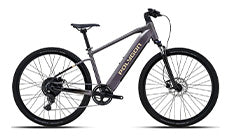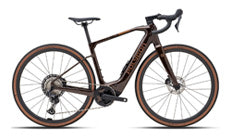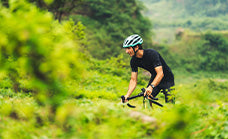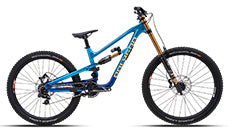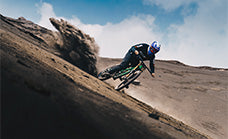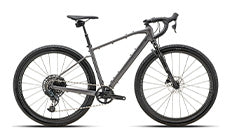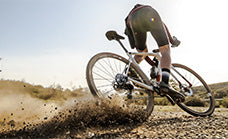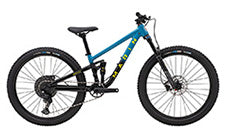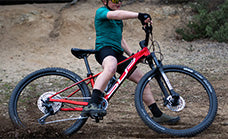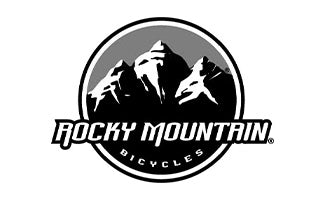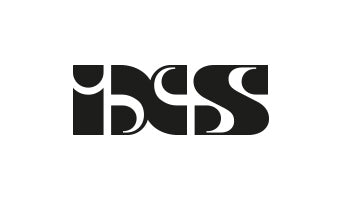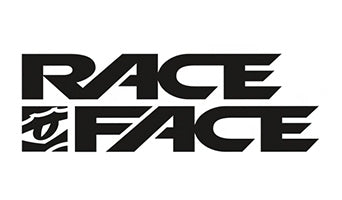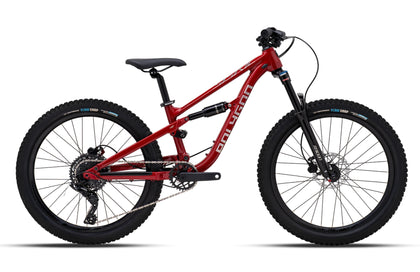
Kids Bike Finder: Find the Perfect Fit
|
|
Time to read 8 min
Helping your child fall in love with cycling starts with a bike that fits them well. When a bike is too big or too small, it can be unstable, intimidating and even unsafe. But sizing kids’ bikes by age alone is unreliable - children of the same age can vary greatly in height and leg length. Cycling experts instead recommend sizing bikes by a child’s inseam (inner leg length) and matching it to the bike’s seat height. Our Kids Bike Finder Tool automates that process, making it easy to choose the right bike without guesswork.
Table of Content
Why Inseam Matters More Than Age
Many bike size charts focus on height and wheel size and ignore inseam (leg length) altogether, yet wheel size recommendations can vary between brands. Choosing a bike based mainly on inseam ensures your child’s feet can reach the ground and pedals comfortably. It also provides room to grow so the bike lasts more than a season. Measuring inseam and matching it to the bike’s seat height is the most accurate way to guarantee a proper fit.
How to Measure Your Child’s Inseam (leg length)
Measuring inseam is quick and requires only a hardbound book and a tape measure:
- Put on riding shoes. Have your child wear the shoes they’ll ride in.
- Stand against a wall. Ask them to stand upright with their back and heels touching the wall.
- Slide a book between their legs. Position a hardcover book spine‑up between their legs until the spine presses firmly against their crotch.
- Mark and measure. Make sure the book is level, then measure from the floor to the top of the book’s spine (or mark the spot on the wall and measure later). This measurement is your child’s inseam.

How to Use the Kids Bike Finder Tool
Our interactive tool turns your child’s inseam into a tailored bike recommendation. It also considers their riding ability, preferred terrain, and colour to fine‑tune the results.
- Enter inseam (required). Input the inseam length you just measured.
- Add optional info. You can also enter height or age for your own reference, though inseam drives the sizing.
- Select riding ability. Choose from learning to pedal, pedalling well or confident solo rider. Ability influences the seat‑height range: learners benefit from a saddle that is even with or just below their inseam so both feet can touch the ground, riders who are pedalling well can raise the saddle slightly above their inseam (about 1–3 cm or roughly ½–1 in), and confident solo riders can set the seat 2–4 cm (≈1 in) higher for more efficient pedalling.
- Pick terrain. Select balance & learning, paths & parks, school commute, mixed trails or MTB trails to filter bikes for where your child will ride.
- Choose desired colours. We know that colour matters for your little shredder, so be sure to choose options that they want.
- Review your results. The tool will suggest a wheel size in inches and centimetres (e.g., 14 in/35 cm, 16 in/40 cm, 20 in/50 cm) and show the seat‑height range, plus a list of BikesOnline AU models in that size with links to their product pages. A 20 in/50 cm recommendation might include bikes like the Polygon Xtrada 20, Reid Viper 20, Reid Tract JR 20, Polygon Relic 20, Marin San Quentin 20 JR, Polygon Premier 20 and Marin Bayview Trail 20.
What the Results Mean
Wheel Size Recommendation
The tool compares your child’s inseam with known seat‑height ranges for each wheel size. A child with a 50 cm (19.6 inch) inseam, for example, may fit both a 16″ (≈40 cm) and a 20″ (≈50 cm) bike; kids who are learning to pedal or pedalling well should opt for the smaller size for easier control, while confident solo riders can move up for more stability.
Seat Height Range
Seat height should correspond to your child’s skill level. For balance bike riders, the seat should be 1–3 cm below their inseam so they can flat‑foot the ground. First‑time pedal riders should have the seat equal to their inseam for stability, while experienced riders can raise it 5–10 cm above inseam for efficient pedalling.
20 inch/50 cm bikes – bridging first and big kids’ bikes
Twenty‑inch bikes fill the gap between a child’s first pedal bike and the larger bikes they’ll ride as tweens. They’re sized for kids who are beginning to ride independently and give them the freedom to commute to school, loop the park with friends and, when ready, tackle their first off‑road trails. Entry‑level 20″ (≈50 cm) bikes use lightweight aluminium frames, rigid forks and 7‑speed drivetrains with V‑brakes for easy control. Mid‑range models swap in wider tyres and simple suspension forks to smooth out bumps, while premium bikes offer adjustable or air‑sprung suspension, wider bars and hydraulic disc brakes for growing confidence. Regardless of spec, 20 inch bikes help riders practise shifting and braking with components designed for small hands and put them on the path to becoming capable solo riders.
24 inch/60 cm bikes – youth hybrids and mountain bikes
By the time kids move to 24 inch (≈60 cm) wheels they’re ready for longer rides and bigger adventures. Entry‑level bikes pair lightweight aluminium frames with rigid or short‑travel suspension and 7 or 8‑speed drivetrains. More advanced cross‑country and trail bikes introduce adjustable or air‑sprung forks, hydraulic disc brakes and 9 or 10‑speed drivetrains. Some models are built for paved paths and light off‑road use, while others include dropper posts and convertible wheel sizes to fit 26 inch wheels as the rider grows.
26 – 27.5 inch bikes – youth/teen performance
For older kids and young teens, 26″ (≈66 cm) and 27.5″ (≈70 cm) bikes deliver near‑adult performance. These bikes feature wide‑range 1× drivetrains, hydraulic disc brakes and longer‑travel suspension or full‑suspension frames, and many accept 27.5″ wheels or mullet setups for added stability. Instead of focusing on weight differences, remember that continued fit is critical: set a reminder every three months to measure your child’s inseam and compare it with the bike’s stand‑over and seat‑height range. Kids can outgrow a bike gradually without it being obvious; moving up a size on time ensures they can still stand over the frame comfortably and reach the pedals and brakes with ease.
Safety and Fit Tips
Kidsafe NSW warns that most cycling injuries occur because the bike is the wrong size. They recommend ensuring a child can touch the ground with both feet while seated and can comfortably reach the handlebars and brake levers. Our tool’s seat‑height guidance helps you achieve this. In addition:
- Check braking systems: Australian regulations require two brakes. Younger kids often use a coaster brake plus a front hand brake; as they gain confidence, transition to two hand brakes.
- Choose a lightweight bike: Lighter bikes are easier to control, especially for smaller riders.
- Adjust as they grow: Use quick‑release clamps to raise the seat and handlebars as your child’s inseam lengthens.
Ready to Find Their Bike?
Using your child’s inseam rather than age means you’ll pick a bike they can control from their first ride, boosting confidence and safety. Our Kids Bike Finder Tool does the maths for you - just enter the inseam and preferences and get a tailored list of bikes that fit today and allow room to grow. Whether your child is ready for their first balance bike or a 26″ trail machine, this tool will point you to the models in our range that match their measurements and ability.
How do I measure my child’s inseam for a bike?
Explain that inseam is measured from the floor to the child’s crotch and is the most accurate way to determine bike sizetwowheelingtots.com. Describe the “book and wall” method and why inseam, rather than age or height, ensures a proper seat‑height range.
Why use inseam instead of age to choose a kids bike?
Note that children’s growth rates vary; relying on inseam and seat height avoids putting a child on a bike that’s too big or too. Mention that an ill‑fitting bike is harder to control and may discourage riding.
What seat height should I set for balance bikes or first‑pedal bikes?
Summarise the rule of thumb: on balance bikes the seat should be about 1–3 cm below inseam so children can plant their feet; for first‑pedal bikes the seat should be roughly level with inseam or slightly above once confident.
What safety features should I look for in a kids bike?
Reference Kidsafe guidelines that recommend well‑adjusted brakes, a chain guard, spoke guards, and reflectors/lights. Remind parents that children must wear an Australian‑approved helmet and ideally ride on footpaths or shared paths until about age 9–10.
Do kids have to wear helmets and can they ride on footpaths in Australia?
Note that wearing a bicycle helmet is mandatory for all cyclists in Australia (including kids); footpath rules vary by state (generally children under 16 can ride on footpaths, but parents should check local regulations). Encourage parents to teach road awareness and use bike paths where possible.
Balance bike vs. training wheels – which is better?
Explain that balance bikes teach steering and balance from the start, making the transition to pedalling easier and often removing the need for training wheels. Training wheels allow pedalling sooner but don’t develop balance as effectively.
When should my child move up from a 20 inch bike to a 24 inch bike?
Suggest basing the decision on inseam and seat‑height fit rather than age; when the seat is at its maximum and the child’s legs are cramped, it’s time to size up. Mention that 24 inch bikes usually suit inseams of ~23–28 inches (≈ 58–71 cm)
How can I tell if a bike is too heavy for my child?
Note that kids should be able to lift and manoeuvre their bike easily; lightweight frames (alloy or magnesium) and scaled‑down components help keep weights reasonable, usually between 2–3 kg for balance bikes and under 10 kg for most 20 inch geared bikes


